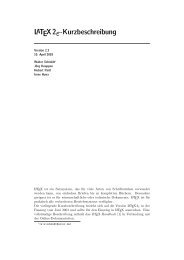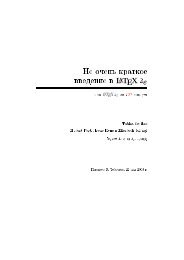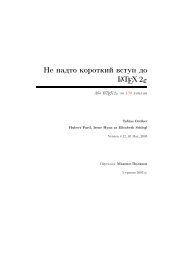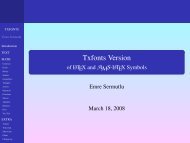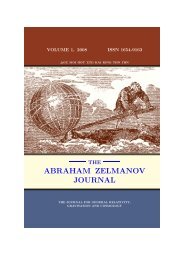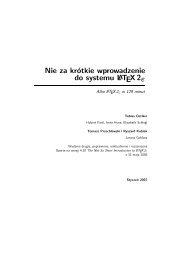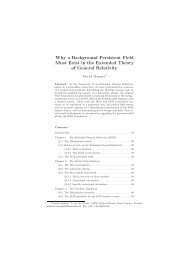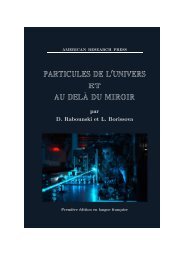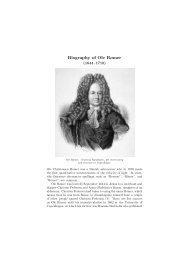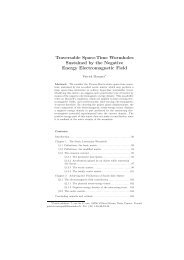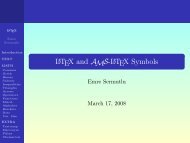The Comprehensive LaTeX Symbol List
The Comprehensive LaTeX Symbol List
The Comprehensive LaTeX Symbol List
Create successful ePaper yourself
Turn your PDF publications into a flip-book with our unique Google optimized e-Paper software.
• <strong>The</strong> symbol isn’t intuitively named. As a few examples, the ifsym command to draw dice is “\Cube”; aplus sign with a circle around it (“exclusive or” to computer engineers) is “\oplus”; and lightning boltsin fonts designed by German speakers may have “blitz” in their names as in the ulsy package. <strong>The</strong> moralof the story is to be creative with synonyms when searching the index.• <strong>The</strong> symbol is defined by some package that I overlooked (or deemed unimportant). If there’s somesymbol package that you think should be included in the <strong>Comprehensive</strong> L A TEX <strong>Symbol</strong> <strong>List</strong>, please sendme e-mail at the address listed on the title page.• <strong>The</strong> symbol isn’t defined in any package whatsoever.Even in the last case, all is not lost. Sometimes, a symbol exists in a font, but there is no L A TEX bindingfor it. For example, the PostScript <strong>Symbol</strong> font contains a “↵” symbol, which may be useful for representinga carriage return, but there is no package (as far as I know) for accessing that symbol. To produce anunnamed symbol, you need to switch to the font explicitly with L A TEX 2ε’s low-level font commands [L A T00]and use TEX’s primitive \char command [Knu86a] to request a specific character number in the font. 4 In fact,\char is not strictly necesssary; the character can often be entered symbolically. For example, the symbolfor an impulse train or Tate-Shafarevich group (“X”) is actually an uppercase sha in the Cyrillic alphabet.(Cyrillic is supported by the OT2 font encoding, for instance). While a sha can be defined numerically as“{\fontencoding{OT2}\selectfont\char88}” it may be more intuitive to use the OT2 font encoding’s “SH”ligature: “{\fontencoding{OT2}\selectfont SH}”.Reflecting and rotating existing symbolsA common request on comp.text.tex is for a reversed or rotated version of an existing symbol.As a last resort, these effects can be achieved with the graphicx (or graphics) package’s \reflectbox and\rotatebox macros. For example, \textsuperscript{\reflectbox{?}} produces an irony mark (“ ”;cf. http://en.wikipedia.org/wiki/Irony mark), and \rotatebox[origin=c]{180}{$\iota$} produces thedefinite-description operator (“ ”). <strong>The</strong> disadvantage of the graphicx/graphics approach is that not every TEXbackend handles graphical transformations. 5 Far better is to find a suitable font that contains the desiredsymbol in the correct orientation. For instance, if the phonetic package is available, then \textit{\riota}will yield a backend-independent “ ”. Similarly, tipa’s \textrevepsilon (“3”) or wsuipa’s \revepsilon (“”)may be used to express the mathematical notion of “such that” in a cleaner manner than with \reflectboxor \rotatebox. 6Joining and overlapping existing symbolsι<strong>Symbol</strong>s that do not exist in any font can sometimes be fabricated out of existing symbols. <strong>The</strong> L A TEX 2ε sourcefile fontdef.dtx contains a number of such definitions. For example, \models (see Table 62 on page 30) isdefined in that file with:\def\models{\mathrel|\joinrel=}where \mathrel and \joinrel are used to control the horizontal spacing. \def is the TEX primitive uponwhich L A TEX’s \newcommand is based. See <strong>The</strong> TEXbook [Knu86a] for more information on all three of thosecommands.With some simple pattern-matching, one can easily define a backward \models sign (“=|”):\def\ismodeledby{=\joinrel\mathrel|}In general, arrows/harpoons, horizontal lines (“=”, “-”, “\relbar”, and “\Relbar”), and the various mathextensioncharacters can be combined creatively with miscellaneous other characters to produce a variety ofnew symbols. Of course, new symbols can be composed from any set of existing characters. For instance, L A TEXdefines \hbar (“”) as a “¯” character (\mathchar’26) followed by a backspace of 9 math units (\mkern-9mu),followed by the letter “h”:\def\hbar{{\mathchar’26\mkern-9muh}}4 pifont defines a convenient \Pisymbol command for accessing symbols in PostScript fonts by number. For example,“\Pisymbol{psy}{191}” produces “↵”.5 As an example, Xdvi ignores both \reflectbox and \rotatebox.6 More common symbols for representing “such that” include “|”, “:”, and “s.t.”.?90



